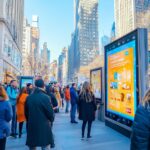In today’s rapidly evolving urban landscapes, understanding foot traffic data is essential for effective urban planning. This article delves into the importance of analyzing pedestrian movement patterns and how these insights can contribute to creating more vibrant, accessible, and sustainable cities. We explore various technological solutions for data collection, the challenges faced by urban planners, and the methods used to gather foot traffic data, while also highlighting successful case studies. Discover how the integration of this information can transform planning processes and benefit communities.
The Importance of Foot Traffic Data in Urban Planning and City Design

Data on foot traffic is essential for urban planning as it offers valuable insights into pedestrian behavior and urban analytics. This information is crucial for enhancing city infrastructure and optimizing urban design.
By analyzing foot traffic patterns, city planners can make more informed decisions to improve walkability, enhance public spaces, and create better mobility patterns in rapidly evolving urban environments. These insights also support the formulation of zoning regulations and impact assessments.
Understanding Foot Traffic Patterns and Trends
Techniques for analyzing foot traffic patterns and trends are valuable for urban planners aiming to enhance public spaces and city infrastructure.
By utilizing spatial analysis methods and real-time data collection, planners can identify peak traffic flow times and visually represent pedestrian behavior through urban heat maps, which assist in making informed decisions.
These techniques not only improve crowd management but also enhance safety by pinpointing areas where congestion is likely to occur. For instance, planners can utilize tools such as RFID and smartphone geo-tracking to gather precise data regarding pedestrian movement.
This data can then be transformed into clear data visualizations that illustrate trends over time, allowing for a more flexible approach to urban design.
Additionally, machine learning algorithms can be employed to predict future foot traffic trends, aiding in the optimal allocation of resources and the creation of adaptable public spaces.
Benefits of Incorporating Foot Traffic Data in Urban Planning

Utilizing foot traffic data in urban planning offers several advantages, including enhanced pedestrian safety, increased community engagement, and more efficient land use. Data analytics play a crucial role in transportation planning and urban sustainability initiatives by assessing their impacts on local businesses and community residents.
Improving walkability is another significant benefit; by analyzing foot traffic patterns, urban planners can identify strategies to enhance walkability, which promotes healthy lifestyles and reduces reliance on vehicles for public transportation. This analysis also assists in determining optimal locations for key public transportation nodes, ensuring that community members have easy access to the features of their urban environment, and supports effective site selection and neighborhood planning.
Additionally, understanding how people flow through spaces helps maintain neighborhood dynamics and fosters a sense of belonging, which positively impacts social interaction and overall community well-being. This holistic approach to urban design supports urban resilience and enhances the quality of life for residents.
Methods for Collecting Foot Traffic Data
Methods for collecting foot traffic data include smart sensors, Geographic Information Systems (GIS), crowdsourcing, citizen feedback and survey data, mobile application data, and social media data.
Urban planners leverage these technological solutions to improve their data collection efforts and enhance urban informatics capabilities.
Technological Solutions for Gathering Data

Technological solutions for gathering foot traffic data, such as smart sensors, interactive mapping, and big data analytics, have significantly enhanced urban planning.
These tools facilitate real-time data visualization and mapping user experiences, enabling planners to access accurate and up-to-date information for knowledge-based decision making.
Incorporating artificial intelligence to analyze the data provides deeper insights into movement and behavioral patterns, offering valuable feedback to city officials regarding the needs of both residents and tourists.
For instance, mobile apps that utilize GPS technology can track pedestrian flows, delivering analytics that assist in various areas, from determining retail placement to developing emergency response strategies.
These technological advancements foster a more responsive urban environment, leading to improvements in aspects such as public transport accessibility and the design of pedestrian-friendly spaces, ultimately enhancing the overall quality of life.
Challenges and Limitations of Data Collection
Despite advancements in data collection methods, several challenges and limitations continue to hinder the accurate gathering of foot traffic data. Issues such as data ethics, privacy concerns, and the need for social equity can complicate urban studies and impede effective policymaking.
Additionally, the variability in technology across different regions can result in disparities in the quality of data collected, making it challenging to draw uniform conclusions. For example, while some urban areas may utilize sophisticated sensors and real-time monitoring systems, rural communities often lack these resources altogether.
The integration of foot traffic data into community planning efforts raises questions about consent and the potential for misuse of information, which can inadvertently marginalize certain populations. As cities strive to create inclusive environments, it is essential to address these technical limitations and ethical dilemmas to foster transparent and effective urban development and ensure urban resilience.
Utilizing Foot Traffic Data in Urban Planning

Utilizing foot traffic data in urban planning involves applying the insights gained to improve various strategies, including community needs assessments, urban renewal, and service efficiency.
Urban planners can leverage foot traffic data to enhance their planning approaches effectively, fostering better connectivity and urban mobility.
Examples of Successful Implementation
There are numerous successful examples of foot traffic data being utilized in urban planning, showcasing its transformative potential. Case studies illustrate how cities have leveraged this data in urban regeneration and placemaking initiatives to enhance the livability of public spaces.
A notable example is the application of foot traffic analytics in the urban regeneration of Barcelona’s Plaça de Catalunya, a significant public square. The data enabled urban planners to customize seating arrangements and landscape architecture to boost the square’s vibrancy.
By analyzing movement patterns, planners identified peak visitor times and designed the square to direct visitors to other key areas, improve traffic flow, and facilitate social gatherings. Tensions arose between local businesses, which aimed to maintain high foot traffic, and community members who desired a more peaceful environment, highlighting the importance of stakeholder engagement in the planning process.
Ultimately, the project resulted in increased foot traffic in the area, benefiting local businesses and strengthening the community’s cultural identity.
Best Practices for Incorporating Data into Planning Processes
Integrating foot traffic data into planning processes involves several best practices, including collaboration with stakeholders and continuous data evaluation to foster cooperation and promote urban sustainability.
By utilizing real-time foot traffic patterns in decision-making, city planners can design spaces that cater to the needs and usage patterns of both local residents and visitors. This approach enables urban areas to prioritize pedestrian-friendly designs, enhance public amenities, and optimize commercial layouts that adapt dynamically to usage trends.
Active involvement from community members, business owners, and urban planners ensures that diverse perspectives are taken into account, ultimately leading to more inclusive urban environments and improving community engagement.
Additionally, leveraging technology for data collection and analysis encourages flexibility in modifying plans to achieve sustainability goals, promoting greener transportation options and reducing ecological footprints.






